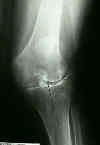- Discussion:
- see rotational alignment in TKR:
- rotational mal-alignment may lead to patellar malalignment and varus-valgus instability;
- valgus knee may have a lateral condyle which is deficient posteriorly;
- therefore, use of the posterior condyles as a reference, may lead to relative internal rotation of the femoral component;
- AP Axis Method:
- line drawn perpendicular to the AP axis of femoral trochlea will most often orient the AP cutting guide in 4 deg of external rotation;
- use a rod placed along the deepest part of the patellar groove and the center of the intercondylar notch for proper orientation;
- when this method is used in a knee w/ a deficiency of the posterior aspect of the lateral femoral condyle, there may be the perception that the
cut will be made in extreme external rotation (as well as under-resection of the lateral femoral condyle);
- pitfalls:
- this method should not be used in revision knees in which the AP landmarks have been destroyed
Femoral Rotational Alignment Based on the Anteroposterior Axis, in Total Knee Arthroplasty in a Valgus Knee. A Technical Note.
Relationship between frontal knee alignment and reference axes in the distal femur.




